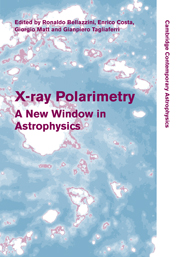Book contents
- Frontmatter
- Contents
- List of contributors
- Preface
- 1 X-ray polarimetry: historical remarks and other considerations
- Part I Polarimetry techniques
- Part II Polarized emission in X-ray sources
- 14 Probing strong gravity effects with X-ray polarimetry
- 15 X-ray polarization from black holes in the thermal state
- 16 Strong-gravity effects acting on polarization from orbiting spots
- 17 Polarization of thermal emission from accreting black holes
- 18 X-ray polarimetry and radio-quiet AGN
- 19 The soft X-ray polarization in obscured AGN
- 20 The polarization of complex X-ray sources
- 21 Polarization of Compton X-rays from jets in AGN
- 22 Polarization of X-ray lines from galaxy clusters and elliptical galaxies
- 23 Polarization characteristics of rotation-powered pulsars
- 24 Polarized X-rays from magnetized neutron stars
- 25 Polarization properties of X-ray millisecond pulsars
- 26 X-ray polarization signatures of neutron stars
- 27 Polarization from the oscillating magnetized accretion torus
- 28 X-ray polarization from accreting white dwarfs and associated systems
- 29 Polarization of pulsar wind nebulae
- 30 X-ray polarization of gamma-ray bursts
- 31 Central engine afterglow from GRBs and the polarization signature
- 32 GRB afterglow polarimetry past, present and future
- 33 Gamma-ray polarimetry with SPI
- 34 INTEGRAL/IBIS observations of the Crab nebula and GRB 041219A polarization
- 35 Fermi results on the origin of high-energy emission in pulsars
- 36 Diagnostics of the evolution of spiral galaxies in a cluster environment
- Part III Future missions
- Author index
- Subject index
26 - X-ray polarization signatures of neutron stars
from Part II - Polarized emission in X-ray sources
Published online by Cambridge University Press: 06 July 2010
- Frontmatter
- Contents
- List of contributors
- Preface
- 1 X-ray polarimetry: historical remarks and other considerations
- Part I Polarimetry techniques
- Part II Polarized emission in X-ray sources
- 14 Probing strong gravity effects with X-ray polarimetry
- 15 X-ray polarization from black holes in the thermal state
- 16 Strong-gravity effects acting on polarization from orbiting spots
- 17 Polarization of thermal emission from accreting black holes
- 18 X-ray polarimetry and radio-quiet AGN
- 19 The soft X-ray polarization in obscured AGN
- 20 The polarization of complex X-ray sources
- 21 Polarization of Compton X-rays from jets in AGN
- 22 Polarization of X-ray lines from galaxy clusters and elliptical galaxies
- 23 Polarization characteristics of rotation-powered pulsars
- 24 Polarized X-rays from magnetized neutron stars
- 25 Polarization properties of X-ray millisecond pulsars
- 26 X-ray polarization signatures of neutron stars
- 27 Polarization from the oscillating magnetized accretion torus
- 28 X-ray polarization from accreting white dwarfs and associated systems
- 29 Polarization of pulsar wind nebulae
- 30 X-ray polarization of gamma-ray bursts
- 31 Central engine afterglow from GRBs and the polarization signature
- 32 GRB afterglow polarimetry past, present and future
- 33 Gamma-ray polarimetry with SPI
- 34 INTEGRAL/IBIS observations of the Crab nebula and GRB 041219A polarization
- 35 Fermi results on the origin of high-energy emission in pulsars
- 36 Diagnostics of the evolution of spiral galaxies in a cluster environment
- Part III Future missions
- Author index
- Subject index
Summary
We explore expected polarization signatures in thermal X-ray emission from magnetized neutron stars. We study the interplay between the photospheres of ordinary and extraordinary modes, and the vacuum resonance. We consider propagation in the neutron star magnetosphere. We identify distinct regimes of magnetic field strengths, and summarize their polarization signatures.
Introduction
We are discussing the state of the art of X-ray polarization detection techniques in this conference, so that it is important to remind ourselves of the expected X-ray polarization properties of various astrophysical objects. In this paper, we give a brief overview of the expected X-ray polarization signatures of magnetic neutron stars found in diverse situations, e.g. in accretion-powered pulsars, low-mass X-ray binaries (LMXBs), recycled pulsars, isolated neutron stars and finally the fascinating magnetars. We concentrate here only on some aspects of the basic physics of radiation propagation around magnetized neutron stars which lead to some basic, expected polarization features in the X-rays which we consider relatively robust. Accordingly, our discussion here is qualitative. Quantitative aspects of a few of these features have been described by other participants of the conference, and detailed calculations on some other aspects will be reported elsewhere.
The X-ray emission we are concerned with here is basically thermal emission from the surface of the neutron star, powered by accretion or otherwise. This radiation propagates through the neutron-star atmosphere, then through the accretion columns over the magnetic poles of the neutron star if it is an accreting one, and finally through the neutron-star magnetosphere.
- Type
- Chapter
- Information
- X-ray PolarimetryA New Window in Astrophysics, pp. 176 - 181Publisher: Cambridge University PressPrint publication year: 2010



